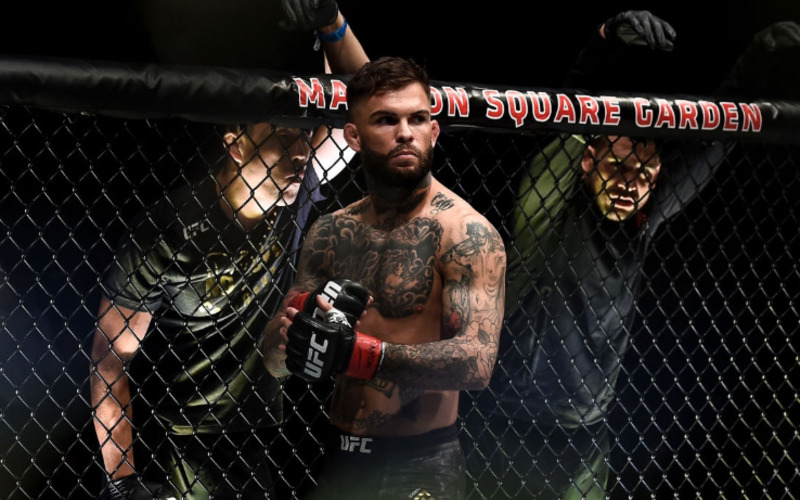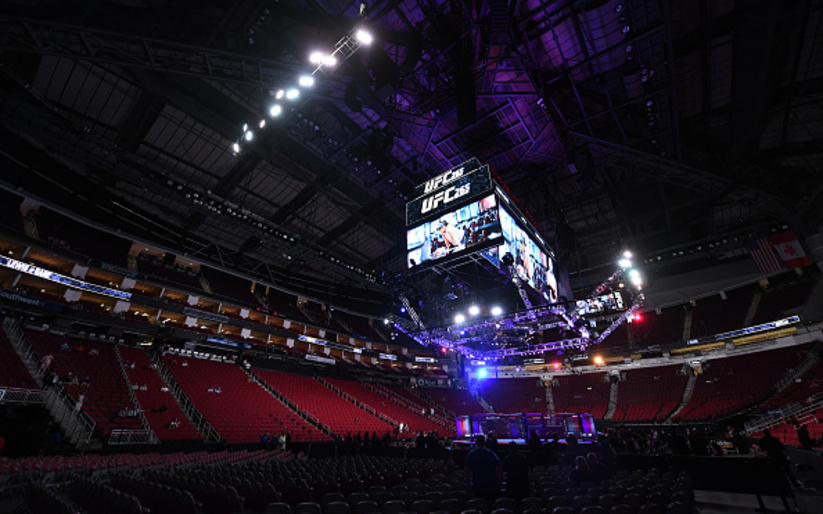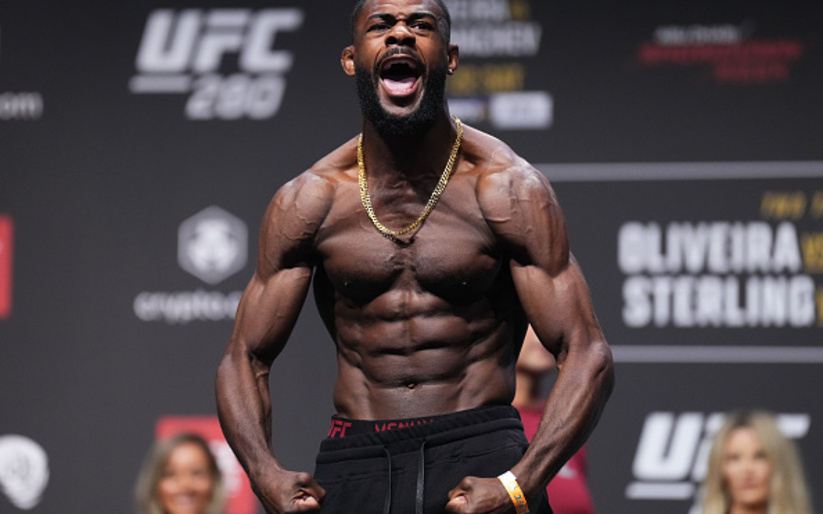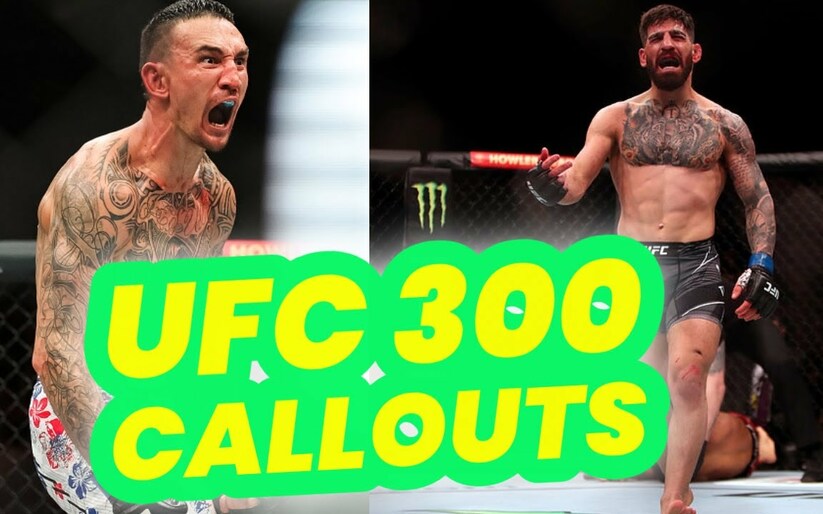Since Cody Garbrandt’s third consecutive knockout loss to #5 ranked bantamweight Pedro Munhoz, a lot has been made of the Team Alpha Male fighter and his tendency to brawl his way out of trouble (often to no avail). This has been of interest to me, because while Cody Garbrandt certainly has issues with swinging wild, these haven’t been the only times he’s found himself on the wrong end of a beating.
In this piece, I will be examining just how deep the problems in Cody Garbrandt’s game go. In my opinion, Cody Garbrandt is no different a technical fighter now than he was when he defeated Dominick Cruz to win the bantamweight title. Only when he realizes that “fighting dumb” isn’t the only hurdle he has to pass can he begin to rebuild his style in a more sustainable, effective way.
Cody Garbrandt Evaluation
Integrating Offense & Defense
The first major flaw worth addressing in Garbrandt’s game is his inability to blend offense and defense. Despite having one of the more prolific amateur boxing records seen in MMA, Garbrandt doesn’t appear to have much ability to layer his defense into his offense or vice versa. As a counterpuncher, Garbrandt is content to sit on the backfoot and wait for an opportunity that his opponent provides. He doesn’t do much in the way of feinting to draw counters, he doesn’t jab, and he has very few weapons to draw from when he’s stranded from a distance.

>Cody has a blisteringly fast, stinging jab that he almost never uses.
Effectively, Garbrandt wants his opponents to walk in on him and attempt to throw combinations, because for the most part of his career, he has been the faster and more powerful puncher. When they do, Garbrandt plants his feet and successively throws a wide 3-2 until the exchange concludes.

>Notice how as soon as Thomas Almeida begins his step-in, Garbrandt drops his left hand all the way down to his hip before marching with a 2-3-2.
A common criticism lobbed against Garbrandt is that he has very little in the way of defense, but I don’t believe this is the correct way to look at the issue. There are times when Garbrandt’s ability to slip and pivot away from danger is quite impressive.

>Against Dominick Cruz, Garbrandt shocked plenty of analysts and pundits with his speed and his ability to diffuse the tricky approach of his opponent. This all comes with a massive caveat, however. Cruz is neither a particularly good counterpuncher, nor is he an especially adept puncher of any kind. Even when Cody is evading the wide, looping punches of Cruz, his hands are parked at his waist. Plus, Garbrandt willingly puts himself way out of position, squaring his stance and taking massive exaggerated movements to evade without keeping sound positioning to counter.

>When Garbrandt finds his moment to counter, his shot selection is always predictable and he often ends up off balance by overthrowing his punches.
The problem isn’t that Garbrandt has no ability to evade incoming fire. The problem is that when Garbrandt commits to throwing back, any semblance of defense disappears. He lacks proactive defense (i.e. weaving under shots after throwing, moving his head while throwing preemptively, angling or pivoting jabs, taking defensive angles before countering).
My friend and fellow analyst Ryan Wagner pointed out that the underlying issue to Garbrandt’s problems seems to be his eyes. He doesn’t have the eyes to see what is coming, and as a result, he cannot make specific reactions. Garbrandt counters everything the same way because he can’t read what his opponent is giving him. He’s left waiting on an opponent instead of creating his own openings.

>Cruz v-steps into range and throws a long overhand left before ducking under Garbrandt’s right hook. Both men end up standing square in the pocket and flurry. Instead of pivoting out and creating an angle on Cruz, Garbrandt just throws the same looping punches from the hip until Cruz is knocked down. He doesn’t move his head after throwing, he doesn’t take an angle on his opponent, and he doesn’t even manage to get out of the way of Cruz’s cuffing punches. Garbrandt wins this exchange just by virtue of being faster and more powerful.
On the opposite side of the spectrum, here are some examples of elite MMA strikers who have developed the ability to blend offense and defense.

>For example, Max Holloway is perhaps the best fighter in MMA at exiting on angles before landing punches back with his opponent blind sighted. Here, he turns a defensive angle to his right from Ortega’s feint into an offensive angle by staying in range and continuing to slide to his right.

>During his best days, Robbie Lawler was one of the finest pocket boxers MMA has ever seen and he mastered the ability to remain in range for minutes on end while remaining defensively active. He blended hand parries and slips to negate the punches of his opponent, while also keeping his offensive counterpunching arsenal available to him. When Hendricks would lean too far in, Lawler would pull back and draw him onto his rear hand power shot.

>Conor McGregor is the rare MMA striker who fights with a cohesive offensive system. He’ll fight long, bait an opponent into reaching for him, and set traps at a distance. When opponents attempt to close him down, he’ll take tight angles (often to the inside of his opponent’s lead foot), and either pull or slip his head offline while countering.
Range & Blind Spots
Immediately after UFC 207, Cody Garbrandt’s performance against Dominick Cruz was regarded as one of the finest showcases in MMA history, and given the prestige of his opponent, I’m not about to dispute that claim. However, Cruz’s success in the fight was largely underplayed, particularly in the fifth round where Cruz appeared to figure out a consistent path to victory against the prospect. The solution was simple: jab.

>Instead of trying to overwhelm Garbrandt in the pocket, Cruz remained at the end of his range and just flashed the jab in Cody’s face, and Cody didn’t appear to know quite what to do about a constant jab. Even when the jab didn’t land, Cody almost never tried to counter off Cruz’s jab or attack his leg to take away the jab.
Garbrandt has neither long reach nor does he extend particularly far with his punches, since most of his boxing comes down to the 2 or the 3. Cruz determined that by fighting long and not attempting to crowd Garbrandt in the pocket, he could land with relative ease and Garbrandt wouldn’t have many ranged weapons beyond naked kicks to stifle him.
Cruz’s typical feints weren’t having much of an effect on Garbrandt, because he wouldn’t bite on anything until Cruz was in range. However, when Cruz did step in, Garbrandt countered with the same combinations every time, so after a certain point, Cruz adapted.

>Cody also lacks urgency and craft in terms of getting off the fence. When Munhoz, Dillashaw, and even Cruz backed Cody up to the cage, they were able to land on him as Cody attempted to circle back to center.
Garbrandt isn’t adept at fighting beyond the first layer of an exchange. As I mentioned before, he lacks the ability to draw counters or responses from his opponents, which means that when Cody does choose to lead, it’s often in wide, predictable patterns that are easily countered.
In keeping his hands low, along with averseness to active defense when throwing, Garbrandt proved to have an enormous blind spot to TJ Dillashaw’s lead right hook in both of their fights. Dillashaw himself isn’t a particularly adept counterpuncher, but Garbrandt’s reliance on waiting for the counter and his complete inability to adjust proved fatal twice.

>Garbrandt feints a single leg and comes over the top with a tight right hook from the hip. Dillashaw easily hops backward, slides his head under the punch, and throws a right hook counter.

>Cody lunges at Pedro Munhoz with a 3-2 from his hip, and Munhoz throws a right hook counter that lands while moving his head hard to the outside of Garbrandt’s cross. A lot has been made about Garbrandt’s lack of durability, but in fairness, it doesn’t take much to get hurt when you let guys throw as hard as they possibly can at you.

>Even Dominick Cruz was able to catch Garbrandt with his stance completely square in the middle of a flurry. All three of these opponents prove just how far moving your head while throwing can go against Cody Garbrandt.
The bantamweight division has caught onto Garbrandt’s patterns, and more and more fighters have shown the ability to solve his fairly predictable approach with progressive ease.
Conclusion
Does Cody Garbrandt have an issue getting drawn into brawls that he can’t win?
The answer is yes, but a qualified yes. While he certainly has an issue with seeing red and trying to hit the kill switch, there are larger issues in Garbrandt’s game that haven’t been examined as thoroughly. Brawling isn’t a choice for Cody Garbrandt. It’s baked into the DNA of who he is as a fighter. His tendency to plant his feet and flurry with wide hooks, paying no attention to where his head is or where his feet are is inextricably locked into his striking arsenal. This is how he’s been coached into fighting.
Garbrandt has shown surprisingly little depth in his striking game, which a lot of analysts have learned retroactively after overestimating him off the Cruz win. In hindsight, Garbrandt’s performance against Cruz (impressive though it was) didn’t evince a particularly deep or even broad striking game. Since then, we’ve seen Garbrandt solved three times in successively brutal fashion, but more damning still is his inability (or perhaps unwillingness) to adapt.
Admittedly, I’ve been somewhat hard on Cody Garbrandt in this article. My intention was never to provide an entirely balanced view of his strengths and weaknesses as a fighter, but rather to debunk the misguided theory that the root of all Garbrandt’s issues is his tendency to brawl his way out of danger. In reality, the issues run quite a bit deeper and will require far more diligent coaching and training to fix.
Main Photo
Embed from Getty Images



